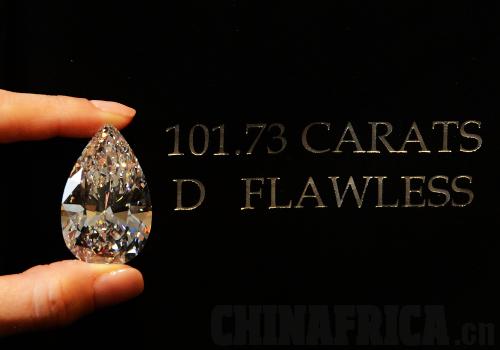| 
The thunderous roar of water falling over
Victoria Falls had to compete with a swarm of politicians who descended on Zimbabwe's tourist haven in mid-August 2014. Heads of state and leaders from Southern African Development Community (SADC) countries were there to attend the 34th SADC Heads of State and Government Summit. Under the theme "SADC Strategy for Economic Transformation: Leveraging the Region's Diverse Resources for Sustainable Economic and Social Development through Beneficiation and Value Addition," the summit was opened by newly appointed chairman of SADC, Zimbabwe's President Robert Mugabe.
Over the two days, discussions ranged from broader political and security issues to socio-economic and regional integration progress. The latter included a specific focus on economic diversification and the role that industrialization could play toward spurring enhanced regional integration of SADC countries.
Resource-endowed
This comes as Southern African countries are among the continent's wealthiest when considering resource endowments. However, although the mining of minerals and metals is a key sector of employment, export earnings and fiscal revenues, the region still grapples with poverty - more than half of the population lives on below $1 a day and is yet to turn the corner toward a more diversified economic growth path. Arguably only South Africa and resource-poor Mauritius have been a relative success story able to transform their economy, broadly speaking from one that was reliant on the business model of mining to one that sees services rather than primary production make up the bulk of economic output. Johannesburg, once a gold mining town, is now home to the richest square mile in Africa - the financial and business services center of Sandton.
Despite an extended upswing in commodity prices in the 2000s, which built significant economic growth momentum in many SADC countries, quantitative growth has not translated into qualitative growth in a number of countries. Arguably, the higher resource price environment has seen a trend in governments eager to increase their share in resource windfalls, but without the necessary complementary requirements of improving their countries' relative competitiveness, and just as much not building on their natural resource wealth as a foundation for economic transformation.
Despite large mineral endowments, SADC country leaders need to realize that natural resource wealth or comparative advantages in natural resource endowments do not simply equate to national competitive advantages, i.e. attracting investment into either downstream or other value-addition sectors linked to the natural resource endowment. For example, iron ore producers such as Australia and Brazil do not feature among the major steel producers globally. Crude producers such as Iran, Iraq, Nigeria or Angola do not refine oil to any extent as Japan or South Korea does. Diamond-rich Botswana looks to India where most diamonds are polished.
Basic building blocks
Manufacturing activity, including this value addition to raw materials, is driven by competitive advantage factors and less so by the availability of natural resource holdings. And, African resource producers have generally struggled to move from raw exports of commodities to other value-added industries or broader industrialization activities. Some of the same barriers that have hindered the continent's economic transformation will also render constraints to any newfangled regional beneficiation strategy, without addressing the basic building blocks required for creating globally competitive economies. One of the biggest hurdles to date remains basic backbone infrastructure and related services, which results in higher transaction costs and hinder the current extraction of resources from pit to port, downstream sectors, as well as other industries linked to global supply chains. Although SADC outshines other regions in terms of road density, mobile and Internet density, as well as generation capacity, electricity coverage and improved sanitation, only one quarter of the regional population has electricity coverage, according to the World Bank.
Bad policies
As argued by the United Nations Economic Commission for Africa in 2007, economic diversification in Africa has been deterred by bad policies, rent-seeking behavior, bad governance, weak institutions, and rigid macroeconomic frameworks, together with low investments (arguably as a result of the former factors). To add to this list, as noted by the recently released World Economic Forum's Global Competitiveness Index (2014-15), is the need for relevant knowledge and skills in order to produce higher value-added industry outputs.
This latter factor input (skills) together with power supply shortages (ample and reliable electricity capacity) are among the most needed requirements in the SADC region before strategies of local or regional mineral value addition are put forward as the silver bullet of economic development and local wealth creation.
Regional markets
While pressing for greater domestic value adds to resources, the role of side-stream beneficiation should not be neglected. The South African Chamber of Mines has previously argued that the prioritization of spinoff industries should just as much be a key policy objective in beneficiation strategies, focusing on support industries to the mining sector, such as financial services, contracting services, engineering, power, transport and other manufactured inputs. This would include backward and sideward linkages into the economy and possibly regional partners in the case of SADC.
Furthermore, promoting beneficiation strategies at the regional level, which could come at the expense of other export-focused manufacturing industries, should be preceded by effectively enhancing cross-border infrastructure efforts, particularly focusing on transport, power, water and ICT infrastructure, in order to boost the movement of goods and regional value chains, and the flow of skills and capital across boundaries to build regional markets. Creating a more competitive environment by lowering transaction costs and promoting an easier business environment could go a long way in attracting investments.
(The author is a director at Frontier Advisory)
|